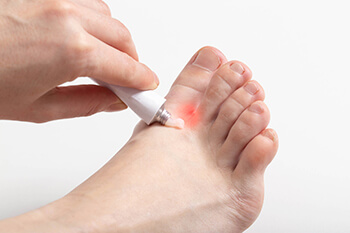
A matrixectomy is a surgical procedure that treats severe toenail issues by removing part or all of the nail matrix, the tissue responsible for nail growth. This type of foot surgery is often recommended for persistent toenail conditions like ingrown toenails or fungal infections that do not respond to conservative treatment. A complete matrixectomy involves the removal of the entire nail matrix, which prevents any future nail growth and can be necessary for severe or recurrent conditions. In contrast, a partial matrixectomy removes only a portion of the nail matrix, preserving some nail growth while addressing localized problems. Both approaches aim to alleviate pain and prevent further complications, with the choice between them depending on the specific condition and its severity. If your toenail is causing chronic discomfort and pain, it is strongly suggested that you visit a podiatrist who can determine if this type of foot surgery is right for you.
Foot surgery is sometimes necessary to treat a foot ailment. To learn more, contact one of our doctors of New England Foot & Ankle . Our doctors will assist you with all of your foot and ankle needs.
When Is Surgery Necessary?
Foot and ankle surgery is generally reserved for cases in which less invasive, conservative procedures have failed to alleviate the problem. Some of the cases in which surgery may be necessary include:
- Removing foot deformities like bunions and bone spurs
- Severe arthritis that has caused bone issues
- Cosmetic reconstruction
What Types of Surgery Are There?
The type of surgery you receive will depend on the nature of the problem you have. Some of the possible surgeries include:
- Bunionectomy for painful bunions
- Surgical fusion for realignment of bones
- Neuropathy decompression surgery to treat nerve damage
Benefits of Surgery
Although surgery is usually a last resort, it can provide more complete pain relief compared to non-surgical methods and may allow you to finally resume full activity.
Surgical techniques have also become increasingly sophisticated. Techniques like endoscopic surgery allow for smaller incisions and faster recovery times.
If you have any questions please feel free to contact our offices located in Wakefield, MA, Nashua and Derry, NH . We offer the newest diagnostic and treatment technologies for all your foot and ankle needs.
 Athlete's foot,
Athlete's foot,



 Dancers
Dancers Orthotics
Orthotics 
 Foot pain
Foot pain